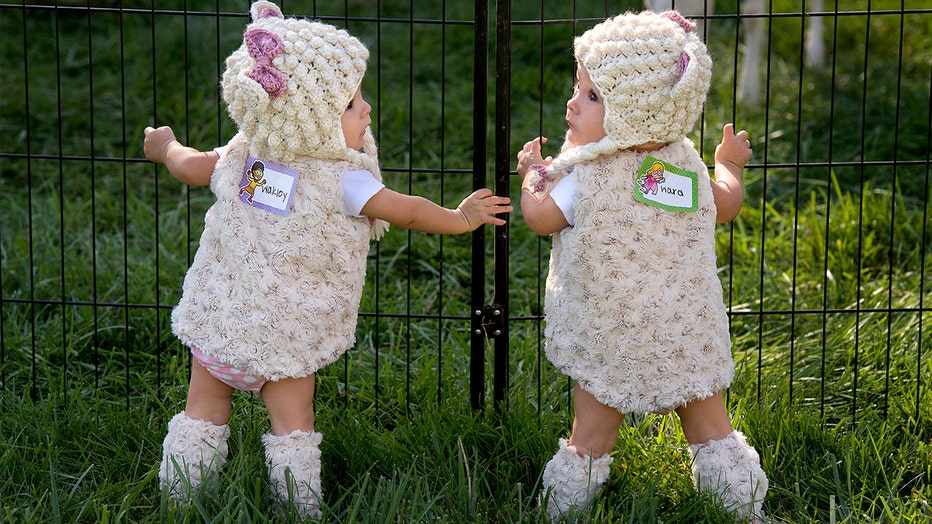Twin birth rate in US hits lowest point in a decade
NEW YORK - After more than three decades of consistent increases, the number of American families welcoming twins is decreasing, and the twin birth rate in the U.S. is now at the lowest point in a decade, the Centers for Disease Control and Prevention reported Thursday.
The most marked decline in twin births today is among mothers aged 30 or older. The rate fell by 10 percent for women aged 30-34, 12 percent for women aged 35-39 and 23 percent for women aged 40 and over.
Twin births steadily increased each year beginning in 1980, and that pattern of growth persisted for three decades. The twin birth rate in the U.S. surged 79 percent between 1980 and 2014, driven largely by older white moms undergoing fertility treatments.
The rate of twin births peaked in 2014 and has since fallen by four percent. Last year, the rate hit its lowest point in a decade — 32.6 twins per 1,000 total births.
The drop is modest, but health officials say it is good news. Pregnancy with more than one raises the risks of complications and death for both the mother and her fetuses. Complications include premature labor and birth, gestational hypertension, anemia and miscarriage, to name a few.
“In the media, there are often stories about very cute twins and talking about how great to have two babies at the same time,” said the CDC’s Dr. Dmitry Kissin. But “these stories don’t focus on the risk.”
Last year, about 124,000 babies born in the U.S. were twins — about 1 out of every 31 births, the same as a decade earlier. When it peaked in 2014, the rate of twin births was at 1 in 29.
The CDC did not release figures on triplets or other multiple births, but said data suggests it’s trending the same way.

The twin birth rate in the United States is declining after nearly three decades of steady increases, according to a report from the Centers for Disease Control. (Keith Myers/Kansas City Star/Tribune News Service via Getty Images)
Why the decline?
Experts can’t say for sure, but Joyce Martin, the report’s lead author, noted the decrease occurred only in white women and in women 30 or older and suggests the declines may have a lot to do with these demographics’ increased likelihood to undergo in vitro fertilization.
“The link between a new mother’s age and the share of multiples born is striking,” pointed out a 2015 Pew Research analysis of CDC data on birth rates. “Among teens, fewer than 2 percent of all babies born are multiples, but this share rises steadily for each subsequent age group. Fully 5 percent of babies born to moms in their late 30s are multiples, a figure that rises to 6 percent for babies born to moms in their early 40s. And for women 45 and older, fully one-in-five babies are multiples.”
Though it is difficult to determine just how much of that increase for older women is due to aging as opposed to medical intervention, a 2015 analysis from the CDC’s National Center for Health Statistics suggested that about two-thirds of the total increase in twin births since the 1980s can be attributed to medical interventions alone.
White women and women over 30 are the biggest customers of expensive in vitro fertilization treatments, which are involved in roughly 15 percent of multiple births. The first successful case of in vitro fertilization was carried out in 1978, just two years before twin birth rates began to climb.
As medical technology has advanced in recent years, there’s been a shift in how in vitro fertilization is done, which likely played into the 7 percent decline in the twin birth rate among white mothers from 2014 to 2018.
Negligible changes were noted in the twin birth rates among non-Hispanic black and Hispanic mothers over the same period of time.
In vitro fertilization involves surgically removing eggs from a woman’s ovaries, combining them with sperm in the laboratory, and transferring the days-old embryo to the woman’s uterus. More than a decade ago, it was standard to implant two or more embryos to improve the chances of success, but that also greatly increased the odds of more than one baby.
Since then, there have been advances in growing embryos longer in the lab and testing them for genetic problems. That’s allowed doctors to select the best single embryo to use, said Dr. Aaron Styer, an infertility treatment specialist in Chestnut Hill, Massachusetts.
The success rate for one embryo rose from about 20 percent in the 1980s to around 50 percent today, he said. Meanwhile, insurers and medical organizations increasingly have been pushing doctors to transfer single embryos more often.Patients have bought into it. They understand that’s the ideal pregnancy, Styer said. Today, about two-thirds of IVF procedures use one embryo, according to the CDC’s Kissin.
This story was reported from Los Angeles. The Associated Press contributed.


